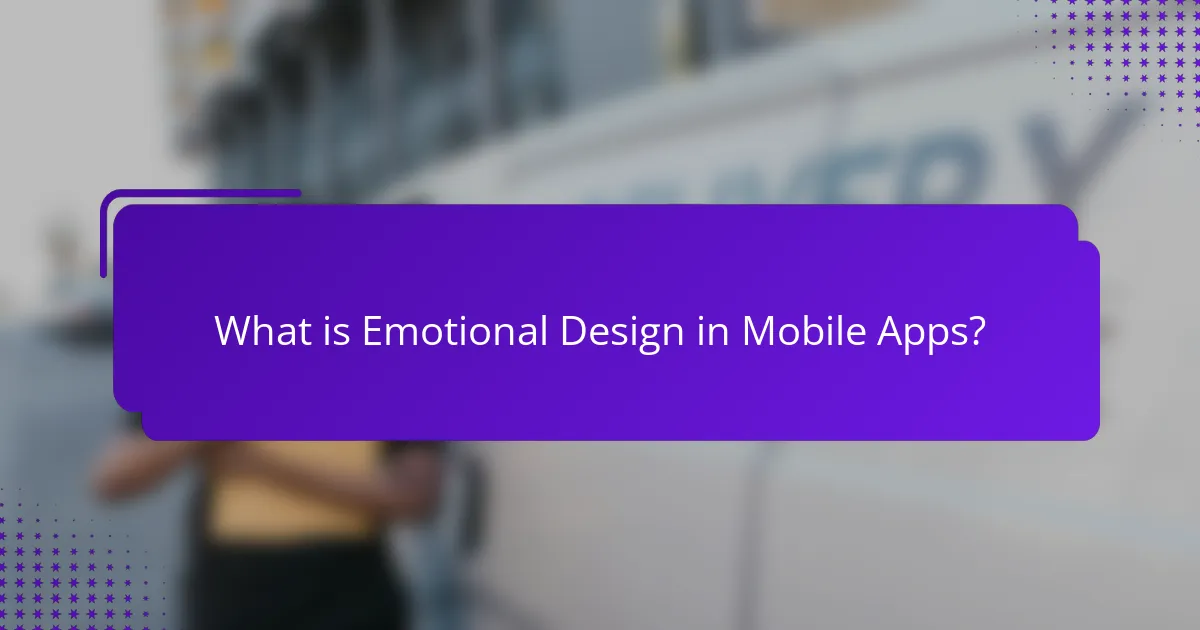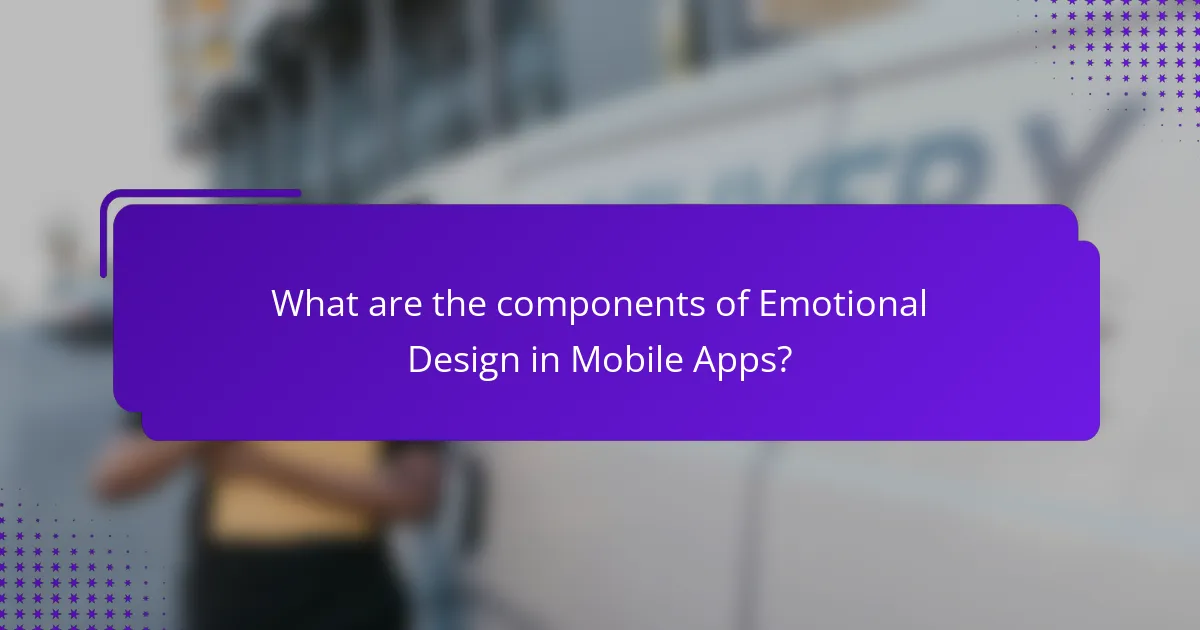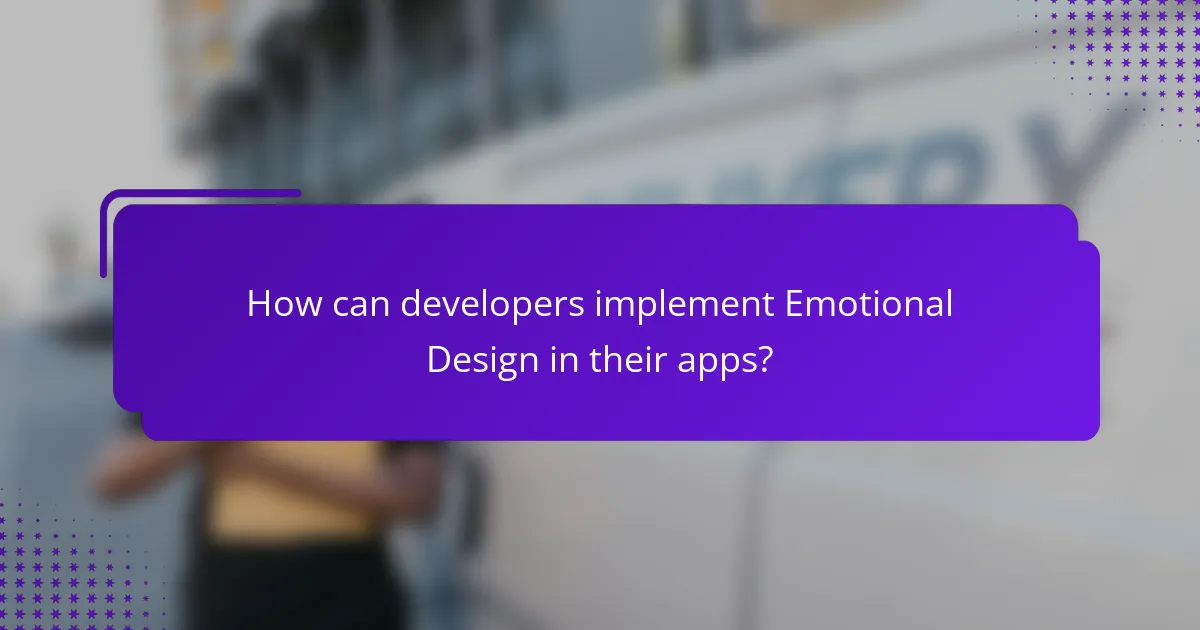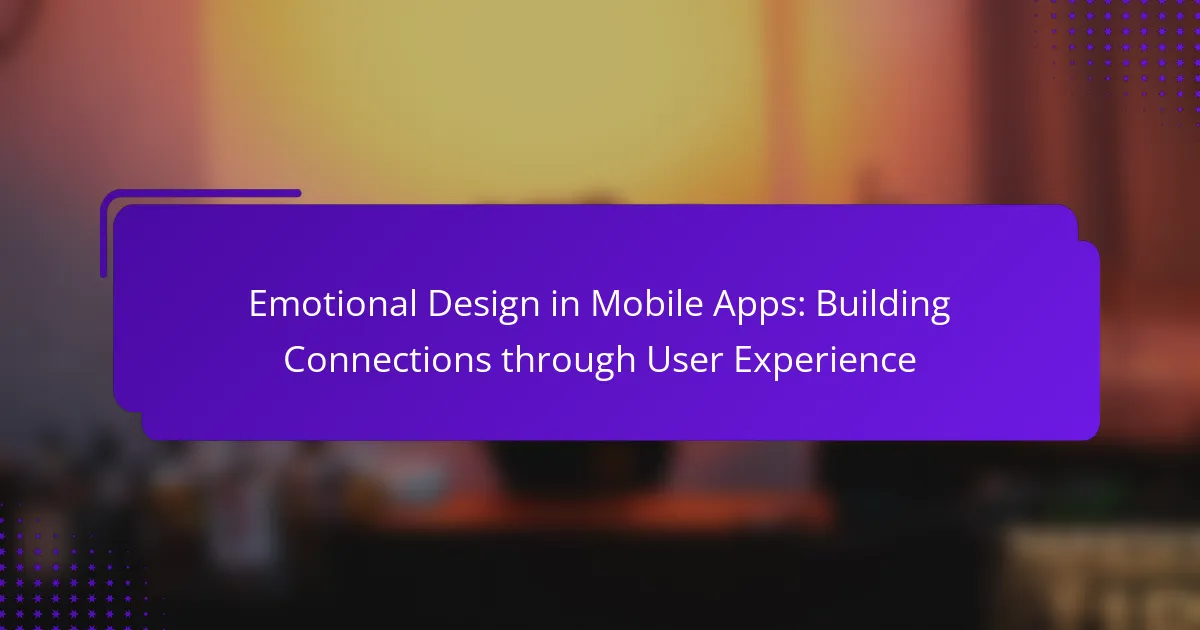Emotional design in mobile apps is the practice of creating user experiences that elicit specific feelings, enhancing user engagement and satisfaction. This approach integrates key components such as usability, aesthetics, and meaningful interactions to foster deeper connections between users and applications. Research indicates that apps designed with emotional engagement in mind can significantly improve user retention rates, sometimes by as much as 50%. Developers can implement emotional design by prioritizing intuitive interfaces, personalized content, effective use of color psychology, engaging storytelling, and community-building features, ultimately leading to greater user loyalty and satisfaction.

What is Emotional Design in Mobile Apps?
Emotional design in mobile apps refers to creating user experiences that evoke specific feelings. This approach focuses on how users feel while interacting with an app. Emotional design enhances user engagement and satisfaction. It involves elements like aesthetics, usability, and storytelling. Research shows that emotionally engaging apps lead to higher user retention rates. For instance, a study by Norman (2004) emphasizes the importance of emotional responses in user experience. By addressing users’ emotional needs, developers can foster deeper connections with their audience.
How does Emotional Design influence User Experience?
Emotional design significantly influences user experience by creating emotional connections between users and products. It enhances user satisfaction and engagement through aesthetically pleasing interfaces. Positive emotions can lead to increased usage and loyalty. Research by Norman (2004) highlights that emotional responses affect users’ perceptions of usability. Additionally, users are more likely to recommend products that evoke positive emotions. Emotional design fosters trust and encourages exploration of features. Ultimately, it shapes users’ overall experiences and influences their long-term relationship with the product.
What are the key principles of Emotional Design?
The key principles of Emotional Design include usability, aesthetics, and emotional resonance. Usability ensures that the design is functional and easy to navigate. Aesthetics focus on the visual appeal of the design. Emotional resonance aims to create a connection with users through relatable experiences. These principles work together to enhance user satisfaction. Research by Donald Norman highlights that emotional design significantly impacts user engagement and loyalty. A well-designed emotional experience can lead to increased user retention and positive brand perception.
How do emotions impact user behavior in mobile apps?
Emotions significantly impact user behavior in mobile apps. Positive emotions enhance user engagement and satisfaction. Users are more likely to return to apps that evoke happiness or excitement. Conversely, negative emotions can lead to frustration and abandonment. A study by Norman Nielsen Group found that 70% of users abandon an app due to poor user experience, often tied to emotional responses. Emotional triggers, such as notifications or interface design, can influence decision-making. Users respond better to apps that create a sense of belonging or achievement. Overall, understanding emotions is crucial for optimizing user experience in mobile applications.
Why is Emotional Design important for mobile app development?
Emotional design is important for mobile app development because it enhances user engagement and satisfaction. By appealing to users’ emotions, apps can create a more meaningful experience. This connection fosters loyalty and encourages repeated use. Research shows that emotionally engaging apps lead to higher retention rates. For instance, users are 3 times more likely to recommend an app that resonates with them emotionally. Additionally, emotional design can differentiate an app in a crowded market. Apps that evoke positive feelings often receive better reviews and ratings. Thus, prioritizing emotional design is critical for success in mobile app development.
What benefits does Emotional Design provide to app developers?
Emotional Design provides significant benefits to app developers by enhancing user engagement and satisfaction. It fosters a deeper connection between users and the app through tailored experiences. This design approach can lead to increased user retention rates. According to a study by Norman Nielsen Group, emotionally engaging designs can improve user satisfaction by up to 50%. Additionally, apps that evoke positive emotions are more likely to receive favorable reviews. This can enhance the app’s visibility and credibility in app stores. Ultimately, Emotional Design can lead to higher conversion rates and increased revenue for developers.
How can Emotional Design enhance user retention and engagement?
Emotional design enhances user retention and engagement by creating meaningful connections with users. It leverages emotional responses to foster loyalty and satisfaction. When users feel emotionally connected, they are more likely to return to the app. Research shows that 75% of purchasing decisions are influenced by emotions. This indicates that emotional design can significantly impact user behavior. Features like personalized experiences and intuitive interfaces evoke positive feelings. These feelings lead to increased user interaction and longer session times. Ultimately, emotional design contributes to a more engaging and fulfilling user experience.

What are the components of Emotional Design in Mobile Apps?
The components of Emotional Design in mobile apps include usability, aesthetics, and meaningful interactions. Usability ensures the app is easy to navigate, which fosters positive user experiences. Aesthetics involve visual appeal, influencing user emotions and engagement. Meaningful interactions create connections between users and the app, enhancing emotional resonance. These components work together to evoke feelings and establish user loyalty. Research shows that emotional engagement increases user retention by up to 50%.
How do visual elements contribute to Emotional Design?
Visual elements significantly enhance Emotional Design by influencing users’ feelings and perceptions. They create visual cues that evoke emotions such as joy, trust, or nostalgia. Colors, for instance, can trigger specific emotional responses; warm colors often generate excitement, while cool colors promote calmness. Typography also plays a role; playful fonts can create a sense of fun, while elegant fonts may convey sophistication. Imagery, including icons and illustrations, can resonate with users’ experiences, making the design relatable. Additionally, consistency in visual elements fosters familiarity and comfort, strengthening user attachment. Research indicates that effective visual design can lead to increased user satisfaction and loyalty, proving its essential role in Emotional Design.
What role do colors and typography play in evoking emotions?
Colors and typography significantly influence emotional responses in design. Colors can evoke specific feelings; for example, blue often conveys calmness, while red can trigger excitement. Typography also affects emotions; for instance, serif fonts may evoke tradition and reliability, while sans-serif fonts can feel modern and approachable. Research indicates that 90% of snap judgments about products are based on color alone. Additionally, the right combination of colors and typography can enhance user experience and engagement in mobile apps. This connection between design elements and emotions is crucial for creating effective emotional design in user interfaces.
How can imagery and animations enhance emotional responses?
Imagery and animations can significantly enhance emotional responses by creating engaging visual experiences. They evoke feelings through color, movement, and context. For example, warm colors can induce happiness, while cool colors may evoke calmness. Animations can illustrate actions or transitions, making interactions feel more dynamic and alive. Research shows that well-designed visuals can increase user retention and satisfaction. A study by Hassenzahl (2010) highlights that aesthetic experiences can lead to positive emotional states. Therefore, incorporating imagery and animations effectively can deepen emotional connections with users in mobile apps.
What are the different types of emotional responses in users?
Emotional responses in users can be categorized into several types. These include happiness, sadness, anger, fear, surprise, and disgust. Happiness often arises from positive experiences, such as user-friendly interfaces. Sadness may occur when users face difficulties or failures in the app. Anger can result from frustrating interactions or unmet expectations. Fear is typically linked to concerns about security or usability. Surprise may emerge from unexpected features or outcomes. Disgust is often triggered by poor design or negative experiences. Understanding these emotional responses helps improve user experience in mobile apps. Studies show that emotional engagement can significantly influence user satisfaction and retention.
How can apps trigger positive emotions in users?
Apps can trigger positive emotions in users by incorporating elements of emotional design. Emotional design focuses on creating experiences that resonate with users on a personal level. Features such as intuitive interfaces enhance user satisfaction. Engaging visuals and animations can evoke joy and excitement. Personalized content fosters a sense of connection and belonging. Social sharing features allow users to celebrate achievements with others. Notifications that celebrate milestones can create feelings of accomplishment. Research shows that emotional engagement increases user retention and satisfaction. Positive user experiences lead to higher app ratings and recommendations.
What strategies can mitigate negative emotional responses?
Cognitive restructuring can mitigate negative emotional responses. This strategy involves changing negative thought patterns into positive ones. Practicing mindfulness helps users stay present and reduces anxiety. Deep breathing exercises can calm the body and mind, lowering stress levels. Engaging in physical activity releases endorphins, improving mood. Social support from friends or family provides comfort and perspective. Implementing these strategies can enhance emotional well-being, particularly in stressful situations. Studies show that cognitive behavioral techniques effectively reduce negative emotions and improve overall mental health.

How can developers implement Emotional Design in their apps?
Developers can implement Emotional Design in their apps by focusing on user experience that evokes feelings. They should prioritize intuitive interfaces that resonate with users. Incorporating personalized content can create a sense of connection. Utilizing color psychology can influence emotions effectively. Engaging storytelling within the app can foster emotional ties. Feedback mechanisms should be designed to acknowledge user actions positively. Creating a sense of community through social features can enhance emotional engagement. Research shows that emotionally designed apps lead to higher user satisfaction and retention rates.
What best practices should be followed for effective Emotional Design?
Effective emotional design involves creating experiences that resonate with users on a personal level. To achieve this, designers should prioritize user empathy. Understanding user needs and emotions fosters deeper connections. Incorporating storytelling elements enhances relatability and engagement. Visual aesthetics play a crucial role; appealing designs evoke positive feelings. Consistent branding reinforces trust and familiarity throughout the user journey. Feedback mechanisms, such as notifications or confirmations, can positively influence user satisfaction. Research shows that emotionally resonant designs improve user retention and loyalty. According to a study by Norman Nielsen Group, emotionally engaging designs lead to better user experiences and increased product success.
How can user feedback inform Emotional Design choices?
User feedback can significantly inform Emotional Design choices by providing insights into user emotions and preferences. It helps designers understand how users feel about their interactions with the app. For instance, feedback can reveal which features evoke positive emotions and which may lead to frustration. Analyzing this feedback allows designers to adjust elements that enhance emotional engagement. Specific surveys and user testing can quantify emotional responses, guiding design decisions effectively. Research shows that apps with user-centered emotional design lead to higher user satisfaction and retention rates. Therefore, leveraging user feedback is crucial for creating emotionally resonant experiences.
What tools and resources are available for designing with emotion?
Tools and resources for designing with emotion include design software, user research methods, and emotional design frameworks. Popular design software like Adobe XD and Figma allow for creating visually engaging interfaces. User research methods such as surveys and interviews help gather emotional feedback from users. Emotional design frameworks, like the Affective Design Framework, guide designers in creating emotionally resonant experiences. Additionally, resources like the book “Emotional Design” by Don Norman provide insights into the principles of emotional engagement. These tools and resources collectively enhance the ability to design mobile apps that foster emotional connections with users.
What common challenges do developers face in Emotional Design?
Developers face several common challenges in Emotional Design. One challenge is understanding user emotions accurately. Developers must interpret complex emotional responses to design features effectively. Another challenge is balancing aesthetics and functionality. Emotional designs can sometimes prioritize visual appeal over usability, leading to poor user experiences. Additionally, integrating user feedback into the design process is often difficult. Developers may struggle to collect and analyze emotional responses from users. Lastly, maintaining consistency in emotional design across different platforms can be challenging. Variations in user experience can dilute the intended emotional impact.
How can developers overcome obstacles in creating emotional connections?
Developers can overcome obstacles in creating emotional connections by prioritizing user-centered design. This approach involves understanding user needs and emotions. Conducting user research helps identify specific pain points. Developers should utilize empathy mapping to visualize user experiences. Incorporating storytelling elements can enhance emotional engagement. Consistent visual design fosters familiarity and trust. Implementing feedback loops allows users to feel heard and valued. Lastly, personalization features can create a sense of ownership and connection.
What are the pitfalls to avoid when implementing Emotional Design?
Common pitfalls to avoid when implementing Emotional Design include neglecting user research, failing to consider cultural differences, and overloading with emotions. User research is crucial; without it, designers may misinterpret user needs. Cultural differences affect emotional responses; ignoring them can lead to misunderstandings. Overloading with emotions can overwhelm users, detracting from usability. Additionally, inconsistent emotional cues can confuse users and diminish trust. Lastly, focusing solely on aesthetics can overshadow functionality, leading to a poor user experience. These pitfalls can hinder the effectiveness of Emotional Design in mobile apps.
What are practical tips for enhancing Emotional Design in mobile apps?
To enhance Emotional Design in mobile apps, focus on creating a user-centric experience. Prioritize intuitive navigation to reduce frustration. Use personalized content to foster a sense of connection. Incorporate visual storytelling to engage users emotionally. Utilize color psychology to evoke specific feelings and moods. Implement feedback mechanisms to acknowledge user actions. Design for accessibility to include all users, enhancing overall satisfaction. Lastly, maintain consistency in design elements to build trust and familiarity. These strategies collectively improve user engagement and emotional resonance in mobile applications.
Emotional Design is the primary entity discussed in the context of mobile apps, emphasizing the creation of user experiences that evoke specific feelings. The article outlines how emotional design enhances user engagement and satisfaction through principles such as usability, aesthetics, and emotional resonance. It explores the impact of emotions on user behavior, the benefits of emotional design for developers, and strategies to implement effective emotional design. Key components, including visual elements like colors and typography, as well as user feedback, are examined to highlight their role in fostering emotional connections and improving overall user experience.
